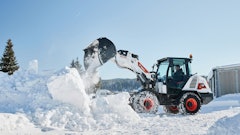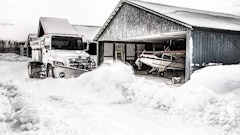If you're like most snow removal contractors, your plow trucks pull double duty during the spring and summer months in your other line of business. That's cool, because many of today's work trucks are spec'd out to perform well in a variety of conditions and climates.
That said, there are obviously some things to keep in mind with respect to operating in colder, sometimes icy conditions. The experts at Ram Truck offer some tips for snow removal contractors as they gear up for what could be another long, cold winter.
To idle or not to idle
Allowing your vehicle to idle has become taboo in this day and age of fuel conservation-mindedness. But when it's cold out, like -10° F or colder, it's important to allow your vehicle to warm up for two or three minutes when you first start it. Nothing crazy, just a few minutes.
That said, if you manage properties where you have to start and stop your truck repeatedly—and leave the truck parked for 15 minutes or more at a time—it's still a good idea to shut the truck off. The only reasons you might want to leave the truck running are if you need to keep the cab warm for operator comfort, or if you need to power some kind of system like a light or PTO.
Fuel, fluids and tires
Extreme cold can definitely affect the various fluids in a vehicle. Always ensure you are using fuel that has the correct chemical traits for your working environment. The same rule applies to anti-freeze, because not all anti-freeze is created equal. Pay attention to your truck owner's manual for recommendations.
If your truck runs on diesel, there are a couple other items to think about. If temps are below zero, a 5W-40 engine oil is recommended. It also might be a good idea to install a cold-weather front to protect against snowpacking under the hood. This also helps keep the engine at operating temps while traveling down the road.
Keep an eye on tire pressure, which can change dramatically with dramatic shifts in temperature. Really cold temperatures can actually drop tire pressure by a few pounds. So keep an eye on it.
Transmission
When plowing, drag is created. The higher the travel speed, the more the drag—which creates resistance for your truck and makes it work harder. Make sure your plow is not blocking airflow over the coolers. Although colder temperatures allow for some leeway, a truck that's maxing out its gross combined weight rating could run into some issues. So be sure to keep an eye on the transmission temperature when plowing, especially uphill when your truck is really having to work.
Another thing to consider is the constant back-and-forth that's often required when plowing. This can take its toll on a transmission. The added weight of a plow and/or fully loaded spreader only compounds the problem.
Avoid shifting until the truck has completely stopped. Engineers factor in some opposing movement, but if the job is comprised of frequent forward and reverse transitions, allowing the truck to stop and the engine to stabilize will help the clutches and syncros realign at lower speeds, reducing long-term wear patterns and heat. Newer transmissions are electronically controlled and will not allow certain events, but older systems may have a mechanical link that allows for a slightly earlier than suggested transition.
Additionally, pay strict attention to recommended oil change intervals and proper fluid use. While lower ambient temperatures can aid in cooling a transmission system, it's a good idea to keep an eye on fluid temperatures—especially when plowing heavy at slow speeds. Heat is the enemy of transmission life.






























